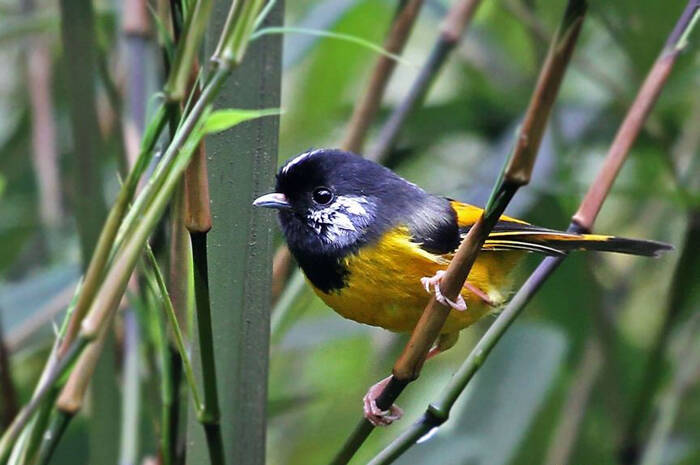Lioparus chrysotis
IUCN
LCBasic Information
Scientific classification
- name:Lioparus chrysotis
- Scientific Name:Lioparus chrysotis,Golden-breasted Tit Babbler,Alcippe chrysotis
- Outline:Songbird
- Family:Passeriformes Ornithogalidae Ophiura
Vital signs
- length:10-11cm
- Weight:About 5.5g
- lifetime:About 3-5 years
Feature
The head is black, with a white central crown stripe in the center of the head, cheeks and ear feathers, and the chest and the rest of the lower body are golden yellow.
Distribution and Habitat
Distributed in China, Nepal, Bhutan, Bangladesh, India (Assam, Sikkim), northeastern Myanmar and northwestern Vietnam. In China, it is distributed in Qinling Mountains in southern Shaanxi, Pingwu, Mianyang, Aba, Maowenzi in northern Sichuan, Wanyuan in the northeast, Emei, Tianquan, Baoxing, Guanxian in the middle, Kangding, Ganzi in the west, Liangshan, Ebian, Mabian, Ganluo in the southwest, Meigu, Leibo, Pingshan in the south, Nanchuan, Fuling in the southeast, Jiangkou in eastern Guizhou, Suiyang and Zunyi in the north, Gongshan and Bijiang in northwestern Yunnan, Yanjin and Yongshan in the northeast, Lushui in the west, the mountains between Longchuan River and Nujiang River, Lancang, Xishuangbanna in the south and Guangxi.
Appearance
Male and female plumage is similar. The forehead, top of the head to the back of the neck are black, the back of the cheeks and ear feathers are white, the front of the eyes, the front of the cheeks, and the sides of the head are black, and there is a white central crown on the top of the head from the forehead through the center of the head to the back of the neck. The rest of the upper body is gray olive green or olive gray. The middle coverts and lesser coverts on the wings are the same color as the back, gray olive green or olive gray, and the primary coverts and greater coverts are black; the flight feathers are brown-black, and the outer edges of the 5 outer primary flight feathers are light yellow. Towards the inner side of the primary flight feathers, this light yellow side is limited to the feather tips and gradually disappears. The outer edges of the secondary flight feathers are orange-yellow with white end spots, and the innermost secondary flight feathers are black, with w
Details
Golden-breasted Tit Babbler, also known as Golden-breasted Tit Babbler, is a small bird of the Warbler family and the genus Babbler, with 6 subspecies.

The appearance and size of the Golden-breasted Sparrow are very similar to the Yellow-bellied Tit (Parus venustulus), but the Yellow-bellied Tit has a short, square tail, not a convex shape, no white central crown on the top of the head, and a white patch on the back of the neck, and two white horizontal stripes on the wings. It is not difficult to identify in the wild.
The Golden-breasted Babbler is a resident bird. It mainly inhabits evergreen and deciduous broad-leaved forests, mixed coniferous and broad-leaved forests and coniferous forests at an altitude of 1200-2900 meters. It also inhabits sparse shrubs and bamboo forests at the edge of the forest and on the hillside. It often moves alone or in pairs, or in small groups of 5-6, especially in autumn and winter, and is often seen in small groups. Sometimes it also mixes with other small birds such as the Greek Babbler. It is timid. It moves quickly, often jumping between branches and bamboo bushes, and frequently shuttles between the bushes under the forest, making "hiss-hiss-hiss" sounds from time to time. If disturbed, it will fly away immediately. It keeps chirping and calling in a low voice. A series of five descending high-pitched notes.
The golden-breasted thrush mainly feeds on insects. According to 17 bird stomachs dissected by Li Guiyuan et al. (1985) in Sichuan, China, all the food eaten was insects and insect larvae of Coleoptera, Lepidoptera, Hemiptera, etc. According to the research conducted by Zheng Zuoxin et al. (1987), Wu Zhikang et al. (1986) and He Xiaorui et al. (1980) in Yunnan and Guizhou, China, the food was almost entirely insects and insect larvae of Coleoptera, Lepidoptera, Hymenoptera, Hemiptera, Diptera, etc., and occasionally a small amount of plant fragments were found in the stomach.
The breeding season of the golden-breasted thrush is from May to July. It usually nests in evergreen broad-leaved forests, mostly in bamboo groves and shrubs under the forest. The nest is cup-shaped. The outer layer is mainly composed of bamboo leaves and grass, the inner layer is mainly composed of moss, grass and roots, and the nest is padded with a few feathers. Each nest lays 3 eggs, which are white, slightly stained with pink, and covered with brown and light ochre spots. The size of the eggs is 17 mm × 13 mm.
The golden-breasted sparrow is not only colorful and an ornamental bird, but also mainly eats insects. It is of great significance in plant protection and should be protected.
Listed in the "Red List of Endangered Species of the World Conservation Union" (IUCN 2016 ver 3.1) - Least Concern (LC).
Listed in the second level of the "List of National Key Protected Wildlife in China".
Protect wild animals and stop eating game.
Maintaining ecological balance is everyone's responsibility!








